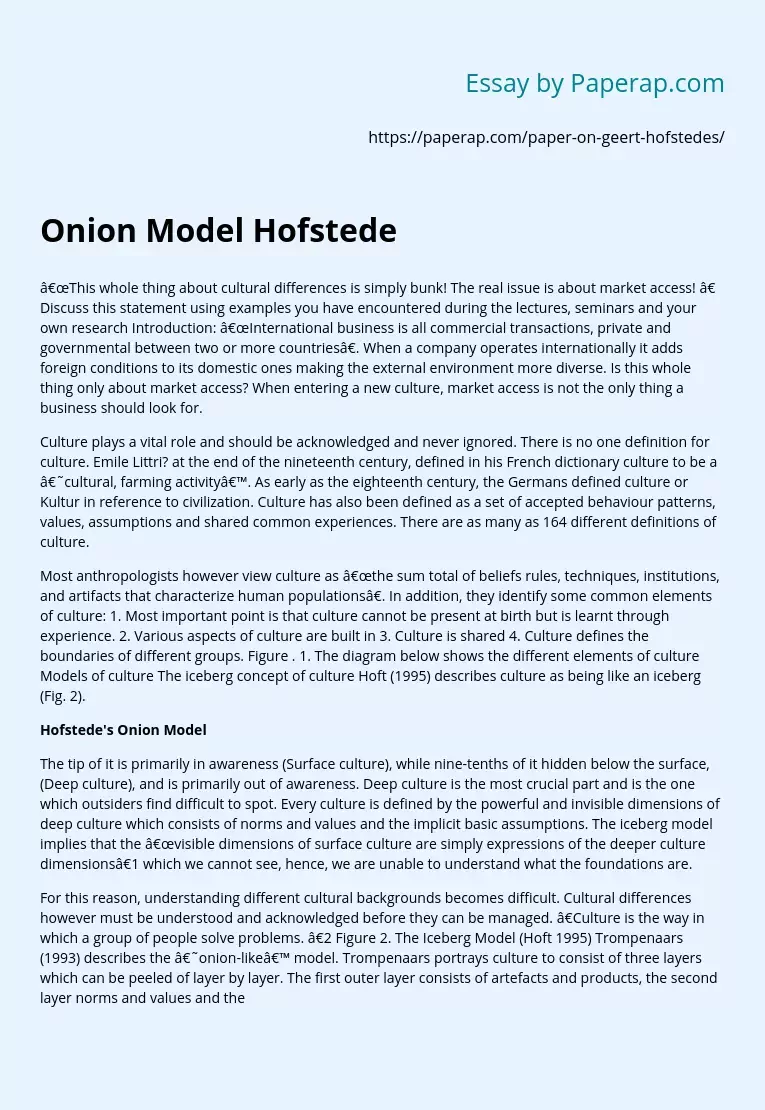Peculiarities and Usage of Onion Model Hofstede
“This whole thing about cultural differences is simply bunk! The real issue is about market access! ” Discuss this statement using examples you have encountered during the lectures, seminars and your own research Introduction: “International business is all commercial transactions, private and governmental between two or more countries”. When a company operates internationally it adds foreign conditions to its domestic ones making the external environment more diverse. Is this whole thing only about market access? When entering a new culture, market access is not the only thing a business should look for.
Culture plays a vital role and should be acknowledged and never ignored. There is no one definition for culture. Emile Littri? at the end of the nineteenth century, defined in his French dictionary culture to be a ‘cultural, farming activity’. As early as the eighteenth century, the Germans defined culture or Kultur in reference to civilization. Culture has also been defined as a set of accepted behaviour patterns, values, assumptions and shared common experiences.
There are as many as 164 different definitions of culture.
Most anthropologists however view culture as “the sum total of beliefs rules, techniques, institutions, and artifacts that characterize human populations”. In addition, they identify some common elements of culture: 1. Most important point is that culture cannot be present at birth but is learnt through experience. 2. Various aspects of culture are built in 3. Culture is shared 4. Culture defines the boundaries of different groups. Figure . 1. The diagram below shows the different elements of culture Models of culture The iceberg concept of culture Hoft (1995) describes culture as being like an iceberg (Fig.
2).
Hofstede’s Onion Model
The tip of it is primarily in awareness (Surface culture), while nine-tenths of it hidden below the surface, (Deep culture), and is primarily out of awareness. Deep culture is the most crucial part and is the one which outsiders find difficult to spot. Every culture is defined by the powerful and invisible dimensions of deep culture which consists of norms and values and the implicit basic assumptions. The iceberg model implies that the “visible dimensions of surface culture are simply expressions of the deeper culture dimensions”1 which we cannot see, hence, we are unable to understand what the foundations are.
For this reason, understanding different cultural backgrounds becomes difficult. Cultural differences however must be understood and acknowledged before they can be managed. ”Culture is the way in which a group of people solve problems. ”2 Figure 2. The Iceberg Model (Hoft 1995) Trompenaars (1993) describes the ‘onion-like’ model. Trompenaars portrays culture to consist of three layers which can be peeled of layer by layer. The first outer layer consists of artefacts and products, the second layer norms and values and the third inner implicit layer of the onion represents basic assumptions.
Figure 3. The onion-like model Trompenaars F. (1993) A set of basic assumptions is developed by each and every different culture which is measured by dimensions. Cultures distinguish themselves from each other in the way they deal with these dimensions. Geert Hofstede’s model of cultural dimensions (The Hofstedes’s Studies) Geert Hofstede carried out a study in forty countries on IBM, a multi-national company. His aim was to identify the basic dimensions of differences between national cultures and he discovered four such dimensions.
Power distance: ‘this is the extent to which an unequal distribution of power is accepted by members of a society’. It is about hierarchy. Hofstede’s findings revealed that the countries with low power distance included Australia, Israel, Denmark and Sweden and those with high power distance were the Philippines, Mexico, Venezuela, India and Brazil. Femininity-masculinity: ‘this dimension refers to the extent to which highly assertive masculine values predominate (acquisition of money at the expense of others) versus showing sensitivity and concern for others’ welfare and the quality of life’.
Japan Australia, Venezuela, Italy and Mexico were found to be high on this dimensions compared to countries such as Thailand, Finland, Denmark, Sweden and Yugoslavia. Uncertainty avoidance: ‘is the extent to which members of a society feel threatened by ambiguous situations and have created beliefs and institution which try to avoid these’. Greece, Portugal, Japan, Peru and France were countries which had high on uncertainty avoidance while Denmark, Sweden, Britain, the USA and India were low on this dimension.
Peculiarities and Usage of Onion Model Hofstede. (2019, Dec 05). Retrieved from https://paperap.com/paper-on-geert-hofstedes/

